A rare art exhibition by a father and son duo proved to be pleasantly entertaining as well as poignant and insightful. Joo Jae-hwan was an important figure in the minjung art movement, which resisted military dictatorship in the 1980s. His son, Ho-min, a popular webtoon artist, has clearly inherited his father’s knack for storytelling with wit and humor.
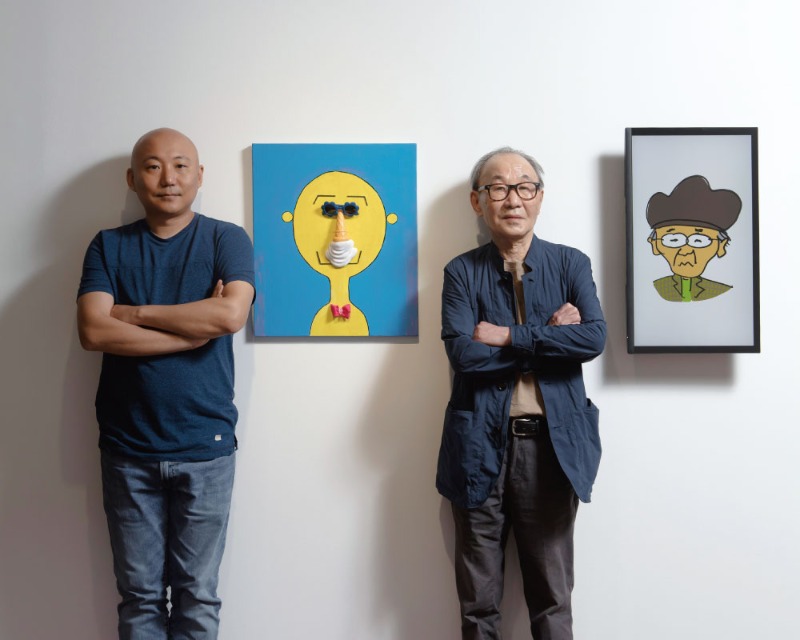
“Portrait of Homin” (left). Joo Jae-hwan. 2020. Acrylic on canvas, plastic toy. 53.2 × 45.5 cm. “Portrait of Joo Jae-hwan.” Joo Ho-min. 2021. Digital drawing.Painter Joo Jae-hwan and webtoon creator Joo Ho-min, who are father and son, pose in front of their portraits of each other, hung side by side at the Seoul Museum of Art. Joo Jae-hwan, the father, has viewed the major incidents of modern history with a keenly humorous eye, and his son is famous for the webtoon “Along with the Gods,” which is a witty take on the boundary between life and death based on Korean myths. © Park Hong-soon, Monthly Art
Are you tired of lofty, incomprehensible art exhibitions and simply want to enjoy art without having to think too much? “Homin and Jaehwan” delivered just that. Held from May 18 to August 1 at the Seoul Museum of Art, the exhibition seemed lighthearted at first glance, but was never without depth. The uniquely acerbic exhibits brought social issues to the fore without feeling grim; the candor and humor underlying the two artists’ works were thought-provoking as well as entertaining.
Joo Jae-hwan has delivered his messages mostly through a combination of image and text. His texts are poetic metaphors that prompt viewers to imagine an implied narrative. In contrast, Joo Ho-min explicitly presents text as a narrative message in speech bubbles, offering cinematic imagination. The joint exhibition by this father-son duo highlighted the similarities and differences in their methods of employing image and text in their respective genres.
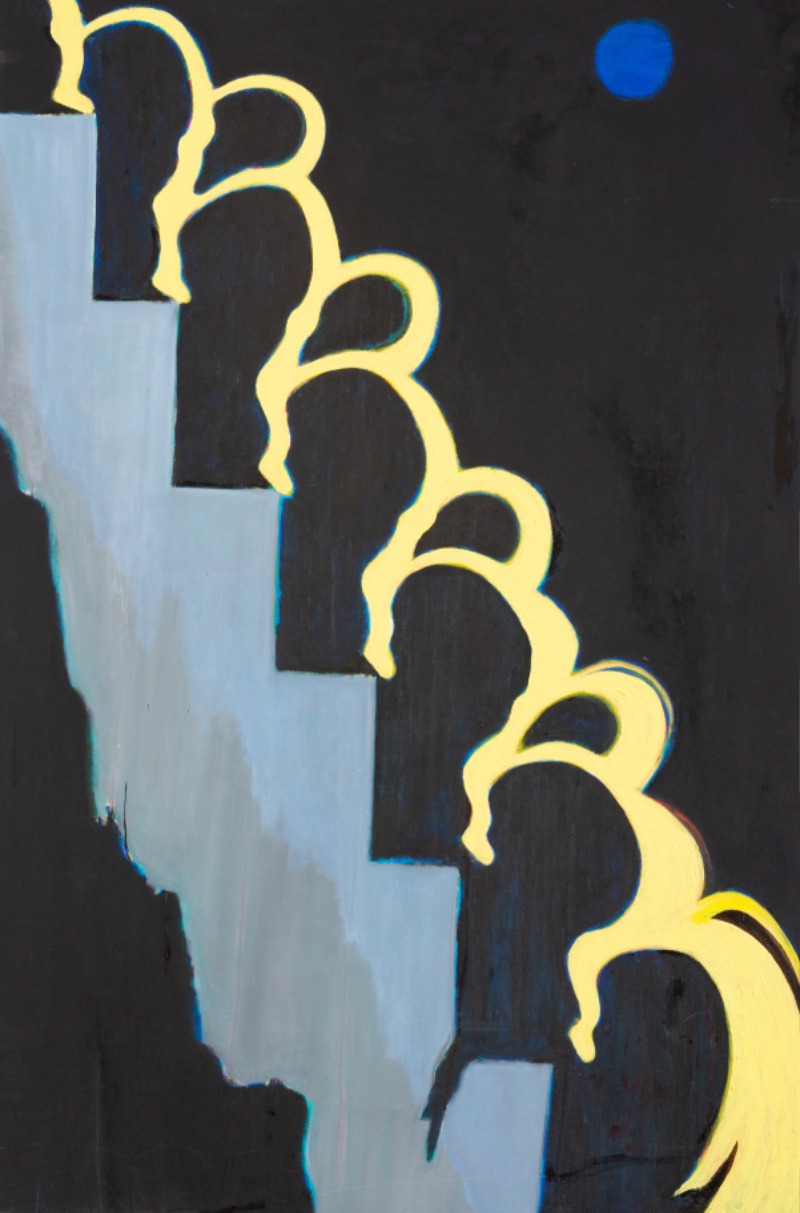
“Spring Rain Descending a Staircase.” Joo Jae-hwan. 2010. Acrylic on canvas. 193.7 × 130 cm.This work was first displayed in the inaugural exhibition of the Reality and Utterance art collective in 1980. A parody of Marcel Duchamp’s “Nude Descending a Staircase,” it satirically expresses the absurdities and oppression suffered by the socially marginalized. Over the following 10 years, Reality and Utterance led socially engaged art through the minjung misul (“people’s art”) movement.
The Father
Joo Jae-hwan began studying Western painting at Hongik University in 1960, but dropped out due to family circumstances. He tried his hand at several jobs before settling as an artist when he was nearing 40. “I began my career as an artist naturally, as if I was born to do so,” he said.
The art collective, “Reality and Utterance,” which was formed in 1980 and dissolved 10 years later, initiated the minjung misul (“people’s art”) movement, a turning point for art to become more socially engaged. As one of the founding members, Joo made a strong impression at the group’s first exhibition with his painting, “Spring Rain Descending a Staircase,” a parody of Marcel Duchamp’s “Nude Descending a Staircase.” Several variations have since been made on the theme. The “spring rain” refers to the urine of the men on the staircase. The streak of “rain” that grows thicker as it cascades down the stairs symbolizes the absurdity and oppression that people at the bottom of the social ladder must endure.
As can be seen in his installation works, “Water vs. Illegitimate Children of Water” (2005) and “A Stolen Towel” (2012), Joo gets inspirations from his everyday surroundings. The former is composed of empty beverage bottles and cans hanging from a huge drying rack, hinting at environmental issues; the latter raises the question of a lack of morality in modern society through a towel supposedly stolen from a neighborhood sauna. Joo recycles abandoned everyday objects to convey a social message with a touch of humor and satire, which are the defining characteristics of his art. In a recent interview, he compared his extensive art world and sense of humor to “an intransitive verb rather than a transitive verb.” He added, “I have had this unchanging belief to this day that I should not make viewers yawn at my exhibition. But time has taught me that every artist has a world of their own.”
During his younger years, Joo rebelled against social inequality, military dictatorship and Korea’s stereotypical monochrome paintings. Living in a democratized society, he has now calmed down and often finds himself thinking deeply about how “everyone has reasons of their own.” He learned that “there are always two paths in society – a path of hope and a path of despair – intertwined to go along together. It is human fate to embrace both positivity and negativity.” He went on to confess that he also learned how helpless an artist is.
“Once your work is hung on the wall for exhibition, you become powerless. Evaluation is entrusted to the viewers. And when the viewers find something new that you’ve never thought of yourself, then it becomes a whole new learning experience.”
On this very point, Joo Ho-min is in rapport with his father. He strongly values what his readers think. He grew up watching his artist father at work from over his shoulder. Probably influenced by his father, he began drawing cartoons in middle school and was pleased to see his friends having a good laugh over his work. He has since become “addicted” to the instant feedback of people reacting to his cartoons. Wanting to “give them bigger laughs,” his career began in 2000 when he started uploading his cartoons to an internet community site.
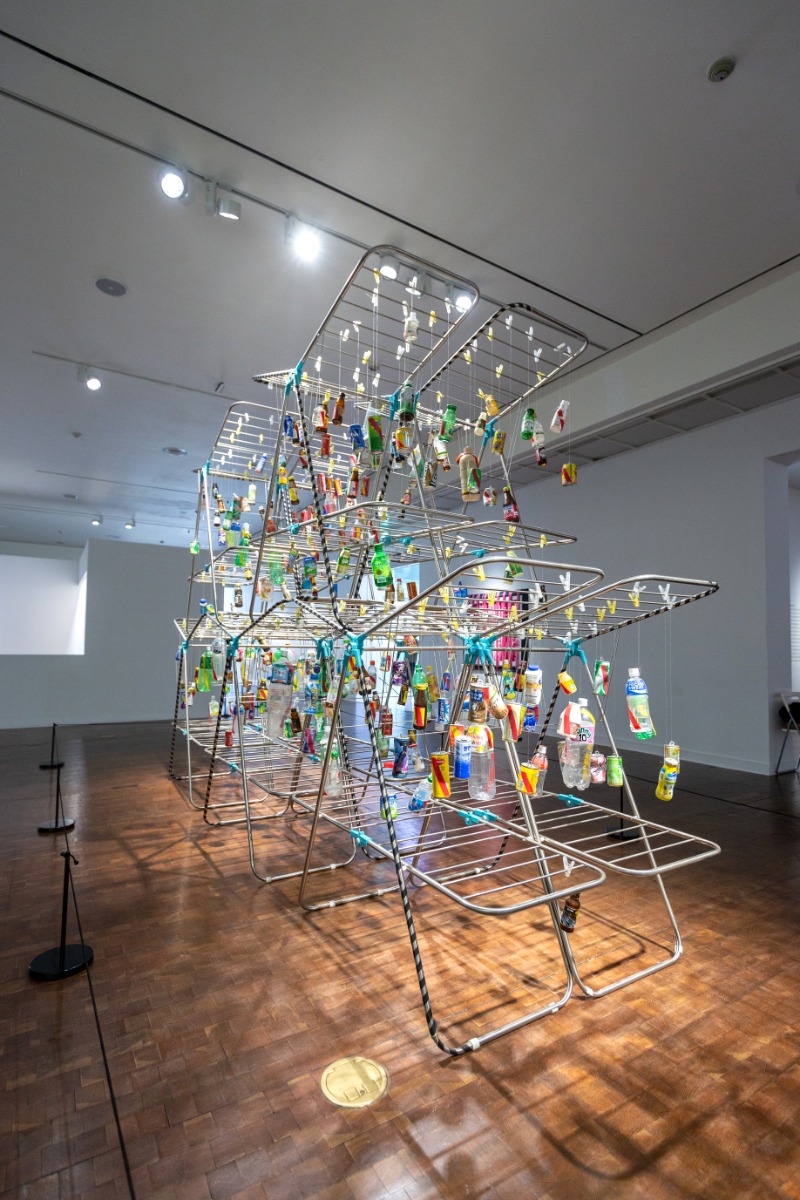
“Water vs. Illegitimate Children of Water.” Joo Jae-hwan. 2005. Aluminum drying rack, various drinks. Dimensions variable.Empty PET bottles and cans hang from a large drying rack as a warning about environmental issues. In this visual commentary on modern man’s desires and double standards in consumption, Joo focused on the fact that the more carbonated drinks you consume, the thirstier you get.
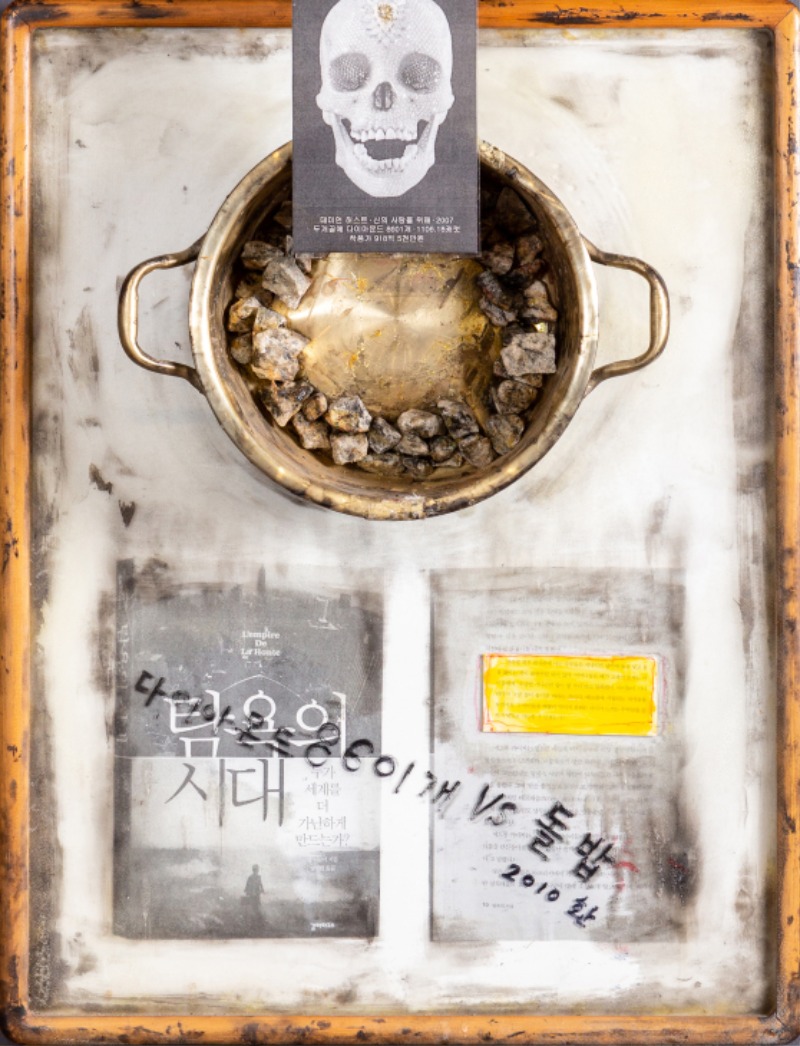
“8601 Diamonds vs. Stone Rice.” Joo Jae-hwan. 2010. Pot, stones, copy of a photo in glass frame.70.8 × 53.7 cm.The story of a mother living in a poor neighborhood in Brazil who has to put a hungry child to sleep isjuxtaposed with Damien Hirst’s “For the Love of God,” a platinum human skull covered in diamonds, to pinpoint income disparity in a capitalist world.
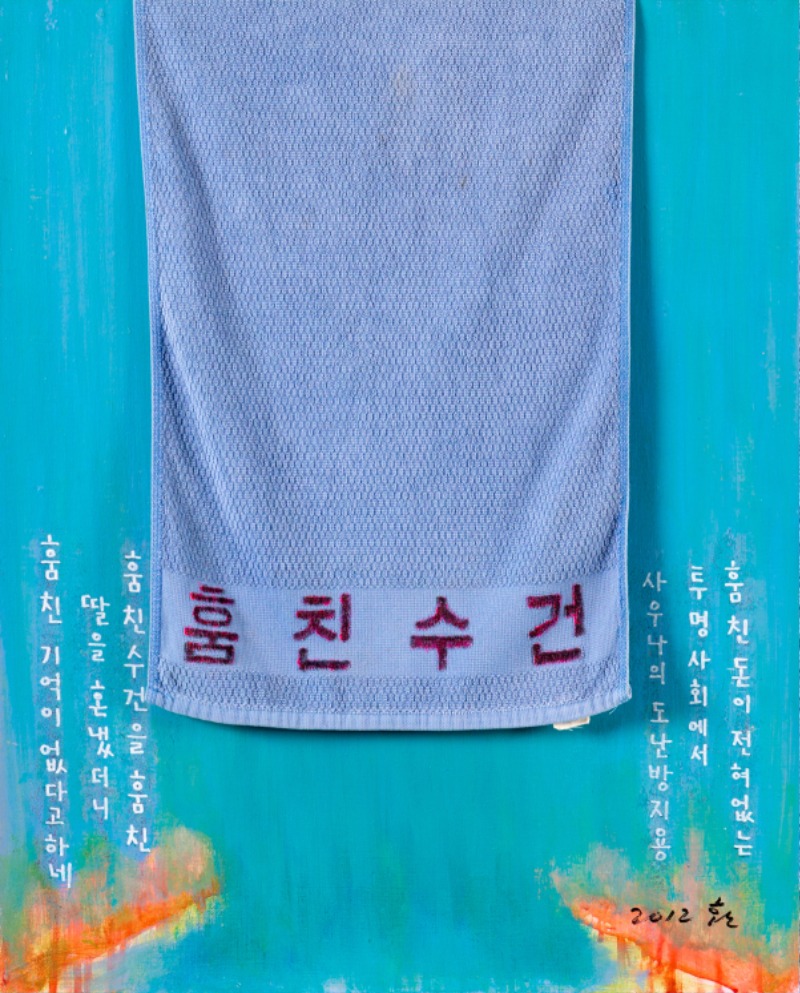
“A Stolen Towel.” Joo Jae-hwan. 2012. Acrylic on canvas, towel collage. 66 × 53 cm.This work satirizes the lack of ethics in people who steal towels from public baths in their neighborhood.Joo Jae-hwan selects familiar, mundane objects and episodes as his motifs for intuitive expression.
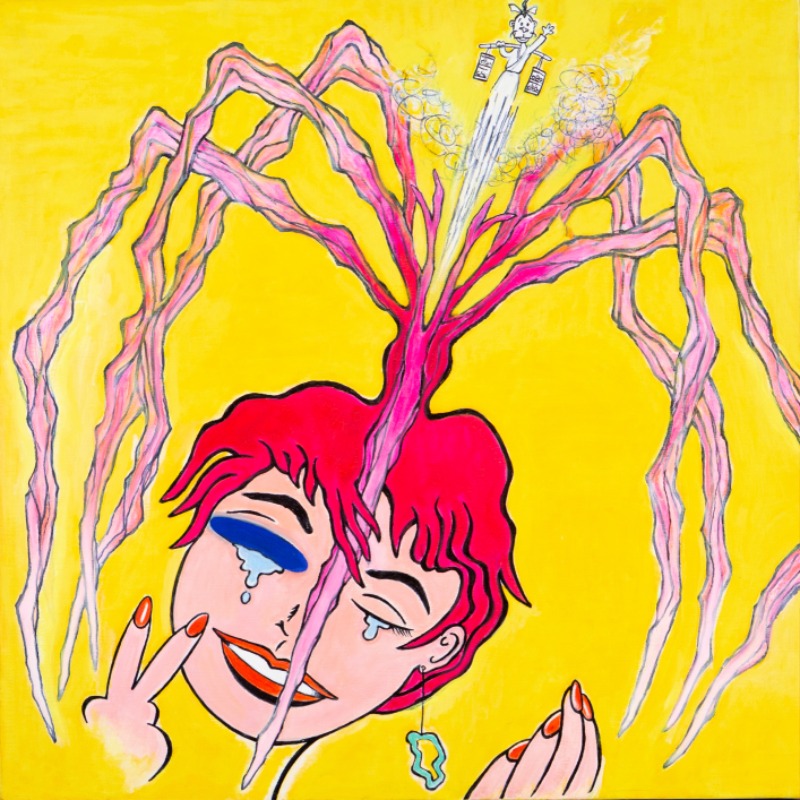
“Happy Tears.” Joo Jae-hwan. 2008. Acrylic on canvas, marker ink. 96.3 × 96.5 cm.This is a parody of Roy Lichtenstein’s “Happy Tears.” Involved in a case of illegal funds accumulated by a Korean conglomerate, which made headlines in 2008, it delivers a message about polarized society.
Father and son, fine arts and webtoons, analog and digital, image and text, all placed side by side, “Homin and Jaehwan” was a jubilant festival for everyone who enjoys a bit of storytelling.
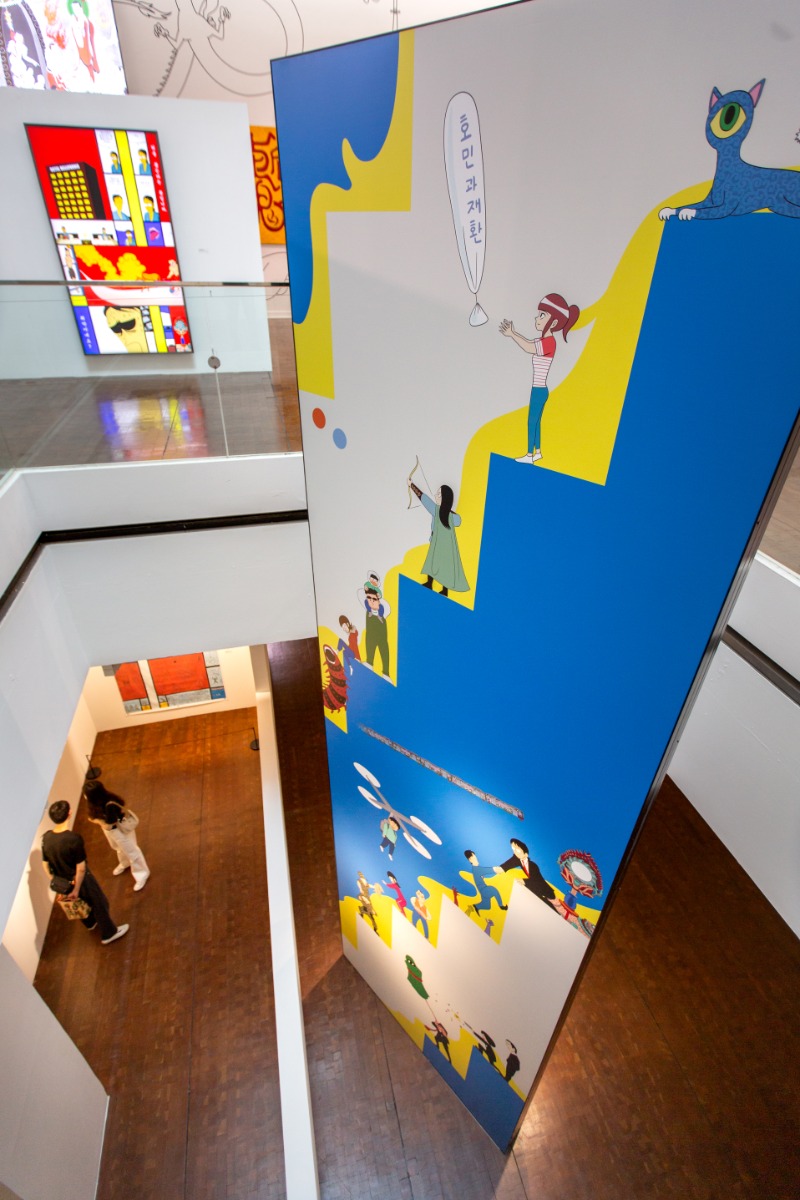
“What Are They Doing Down the Stairs?” Joo Ho-min. 2021. Digital flex print. 740 × 220 cm.Joo Ho-min’s large installation parodies his father’s well-known painting, “Spring Rain Descending a Staircase.” It is his reinterpretation of his father’s sense of humor and resistance.
The Son
The younger Joo made his name known with “Jjam” (2005), his official debut work about military life, and became one of Korea’s most famous cartoonists with the hit series, “Along with the Gods” (2010-2012), a fantasy action story about death and reincarnation through seven trials in hell. “Along with the Gods: The Two Worlds” (2017), the film adaptation of the web comics, attracted over 14 million viewers, the third largest audience in the history of Korean cinema. The sequel, “Along with the Gods: The Last 49 Days” (2018), was also successful, drawing over 12 million viewers.
As a YouTube streamer with 230,000 subscribers, Ho-min confessed that he “wanted to run away” while preparing for the “Homin and Jaehwan” exhibition because “comics are not for exhibition, so they look awkward when displayed on a museum wall.” He was nervous about how it would be received by viewers, but such worries turned out to be needless.
The paintings and installations of Joo Jae-hwan that filled the second floor of the museum provided plenty to see. In comparison, the third floor looked somewhat bland, with digital prints of important scenes from Joo Ho-min’s major works and his sketchbooks of storyboards on display. Nonetheless, many visitors carefully examined them and lost themselves in the stories he created. Just as book readers can take flights of imagination by reading between the lines, the sparse space provided a break, allowing visitors to relive the scenes and enjoy the stories even more. The books that the cartoonist used for reference in his creative work were also displayed, showing how ordinary objects can turn into valuable sources of imagination.
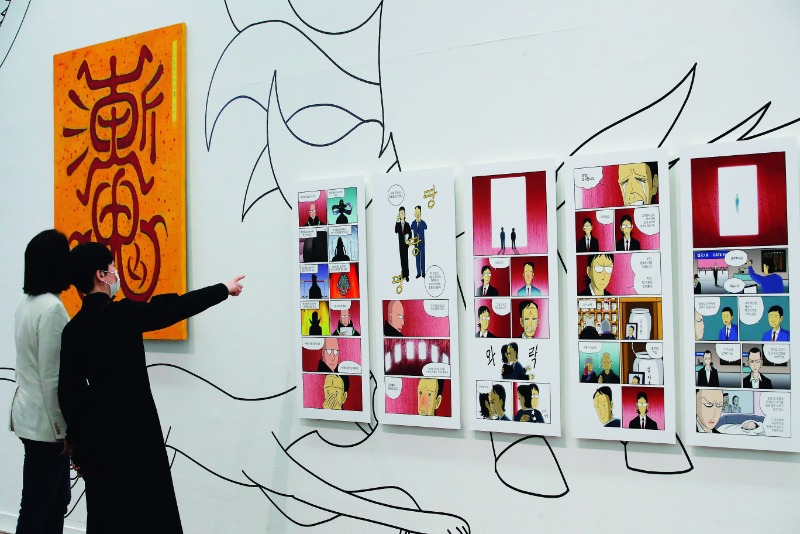
Visitors look at scenes from Joo Ho-min’s webtoon “Along with the Gods: The Two Worlds,” which reflects Koreans’ view of the afterlife. The exhibit features elements from various myths and stories that appear in the webtoon.
Collaboration
Most notably, the exhibition was a collaboration by a father and son who work in different genres. Portraits of the two artists, hung side by side at the entrance of Gallery 1, drew the attention of visitors: “Portrait of Homin” (2020), by the father, is a collage of an ice cream and sunglasses, and “Portrait of Joo Jaehwan” (2021), by the son, is a webtoon-style digital drawing. Both father and son were pleased with each other’s rendition of themselves. The father said that looking at his portrait done by his son made him feel he had “aged well.” The son said that his father’s work was “just so funny.”
The younger Joo created the gigantic installation, “What Are They Doing Down the Stairs?” (2021), which is a parody of his father’s work, “Spring Rain Descending a Staircase.” The father’s work is about descension from top to bottom and movement from left to right, but the son’s work features multiple characters in upward movement, helping and pulling one another, thus extolling cooperation and synergy. It is his own reinterpretation of his father’s spirit of resistance and sense of humor.
Joo Ho-min said that he had taken his artist father “for granted” when he was young, but now, as an artist himself, he realizes “how difficult and wondrous” it all was. He expressed respect for his father, saying, “I already find it challenging, but my father, who is 80 years old, is still working so hard. It amazes me how he kept it up all these years.”
The exhibition concluded with a video show by the streamer son and the painter father. In the format of “pick your favorite” tournament, the younger Joo repeatedly showed his father two of his works at a time and had him choose his favorite. The elder Joo shared stories about the particular artwork he picked, his hopes at the time he created it, and relevant memories about his son.
Asked whether he was displeased to find his name didn’t appear first in the title of the exhibition, Joo Jae-hwan replied that he liked it better that way. “It doesn’t matter if the genre is paintings or cartoons, and it certainly isn’t important whose name comes first. That kind of thinking is very old,” he added.
Father and son, fine arts and webtoons, analog and digital, image and text placed side by side, “Homin and Jaehwan” was a jubilant festival for everyone who enjoys a bit of storytelling.